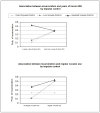Factors related to correctional facility incarceration among active injection drug users in Baltimore, MD
- PMID: 18082337
- PMCID: PMC2774749
- DOI: 10.1016/j.drugalcdep.2007.10.007
Factors related to correctional facility incarceration among active injection drug users in Baltimore, MD
Abstract
Aim: We investigated the moderating effect of impulse control on the association between drug use and incarceration among active injection drug users (IDU).
Methods: The study sample consisted of 282 IDUs aged 15-50 years from the Baltimore metropolitan region who reported injection drug use within the past 6 months and indicated that heroin or speedball was their drug of choice. Impulse control was measured using commission error standardized scores from the Test of Variables of Attention (TOVA). Incarceration was obtained using self-reported lifetime history of incarceration in correctional facilities.
Results: Findings indicated that impulse control moderated the association between years of injection drug use and incarceration in correctional facilities adjusting for ethnicity, gender, estimated pre-morbid intelligence, and age of first injection use. Specifically, among individuals who were intact in impulse control, four or more years of injection drug use was associated with incarceration (AOR=4.97, 95% CI: 2.02-12.23). This finding was not observed among individuals with impaired impulse control (AOR=0.57, 95% CI: 0.10-3.23). Furthermore, impulse control moderated the association between regular cocaine use and incarceration. Among individuals who had a history of cocaine use, individuals with low impulse control but not impaired were more likely to have reported time in a correctional facility (AOR=6.28, 95% CI: 1.68-23.60). There was no association among individuals with impaired or intact impulse control.
Conclusion: Results highlight the importance of considering cognitive measures of impulse control in addressing negative outcomes associated with drug use.
Similar articles
-
Prevalence and correlates of hepatitis A among adult drug users: the significance of incarceration and race/ethnicity.Vaccine. 2007 Oct 10;25(41):7125-31. doi: 10.1016/j.vaccine.2007.07.041. Epub 2007 Aug 13. Vaccine. 2007. PMID: 17766016
-
Incarceration and drug use patterns among a cohort of injection drug users.Addiction. 2009 Jan;104(1):69-76. doi: 10.1111/j.1360-0443.2008.02387.x. Addiction. 2009. PMID: 19133890 Free PMC article.
-
History of injection drug use in the month preceding incarceration in Iranian prisons.Sci Rep. 2025 May 20;15(1):17469. doi: 10.1038/s41598-025-02537-3. Sci Rep. 2025. PMID: 40394234 Free PMC article.
-
Incarceration experiences among a community-recruited sample of injection drug users in Bangkok, Thailand.BMC Public Health. 2009 Dec 30;9:492. doi: 10.1186/1471-2458-9-492. BMC Public Health. 2009. PMID: 20042105 Free PMC article.
-
The harm inside: injection during incarceration among male injection drug users in Tijuana, Mexico.Drug Alcohol Depend. 2009 Jul 1;103(1-2):52-8. doi: 10.1016/j.drugalcdep.2009.03.005. Epub 2009 Apr 21. Drug Alcohol Depend. 2009. PMID: 19386448 Free PMC article.
References
-
- Atkins MS, Stoff DM, Osborne ML, Brown K. Distinguishing instrumental and hostile aggression: Does it make a difference? J Abnorm Child Psychol. 1993;21:355–365. - PubMed
-
- Austin J, Bruce MA, Carroll L, McCall PL, Richards SC. The use of incarceration in the United States. Crit Crim. 2001;10:17–41.
-
- Ball JC, Shaffer JW, Nurco DN. The day-to-day criminality of heroin addicts in Baltimore--a study in the continuity of offence rates. Drug Alcohol Depend. 1983;12:119–142. - PubMed
-
- Belenko S, Peugh J. Estimating drug treatment needs among state prison inmates. Drug Alcohol Depend. 2005;77:269–281. - PubMed
-
- Bolla KI, Cadet JL, London ED. The neuropsychiatry of chronic cocaine abuse. J Neuropsychiatry Clin Neurosci. 1998;10:280–289. - PubMed
Publication types
MeSH terms
Grants and funding
LinkOut - more resources
Full Text Sources
Miscellaneous



